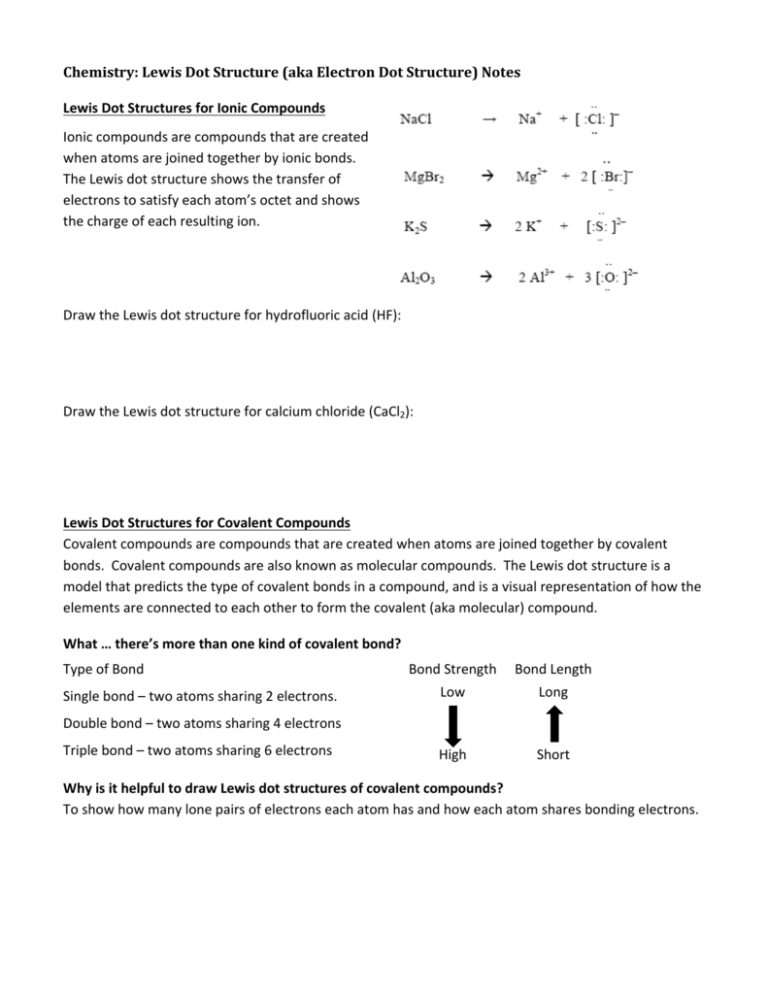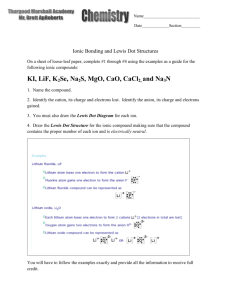Chemistry: Lewis Dot Structure (aka Electron Dot Structure) Notes
advertisement

Chemistry: Lewis Dot Structure (aka Electron Dot Structure) Notes Lewis Dot Structures for Ionic Compounds Ionic compounds are compounds that are created when atoms are joined together by ionic bonds. The Lewis dot structure shows the transfer of electrons to satisfy each atom’s octet and shows the charge of each resulting ion. Draw the Lewis dot structure for hydrofluoric acid (HF): Draw the Lewis dot structure for calcium chloride (CaCl2): Lewis Dot Structures for Covalent Compounds Covalent compounds are compounds that are created when atoms are joined together by covalent bonds. Covalent compounds are also known as molecular compounds. The Lewis dot structure is a model that predicts the type of covalent bonds in a compound, and is a visual representation of how the elements are connected to each other to form the covalent (aka molecular) compound. What … there’s more than one kind of covalent bond? Type of Bond Single bond – two atoms sharing 2 electrons. Bond Strength Bond Length Low Long Double bond – two atoms sharing 4 electrons Triple bond – two atoms sharing 6 electrons High Short Why is it helpful to draw Lewis dot structures of covalent compounds? To show how many lone pairs of electrons each atom has and how each atom shares bonding electrons. The central atom is usually the one with the lowest electronegativity but never hydrogen. Based on the elements’ group numbers. Add all of them together. Use either “● ●” or “─“ to represent a bond. Each bond uses a pair of electrons. Use lone pairs and/or multiple bonds to complete the octets for each atom. See if there are enough electrons to place all lone pairs around each atom. If there aren’t enough, then use one “extra” bond for every two electrons you’re short. Remember, each extra bond counts as two electrons toward each atoms octet. Example: Draw the Lewis dot structure for carbon dioxide (CO2): Draw the Lewis dot structure for methane (CH4): Draw the Lewis dot structure for nitrogen, N2. Draw the Lewis dot structure for the polyatomic anion chlorate, ClO31-­‐. Exceptions to the Octet Rule Less than an Octet Boron only needs 6 electrons to satisfy the octet rule More than an Octet Phosphorous sometimes needs 10 electrons to satisfy the octet rule. Sulfur sometimes needs 12 electrons to satisfy the octet rule. Resonance Structures Some compounds have more than one Lewis dot structure that explains the bonding patterns. These multiple structures are called resonance structures. Draw the 2 possible Lewis dot structures for ozone, O3. Draw the 3 possible Lewis dot structures for sulfur trioxide, SO3.






